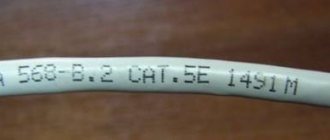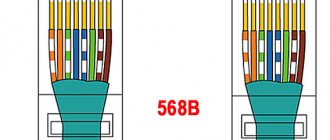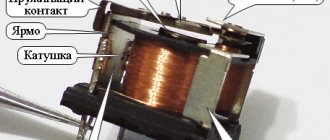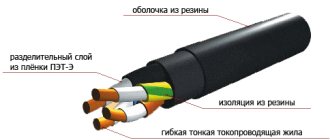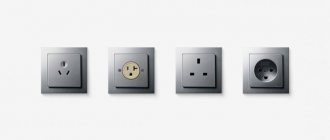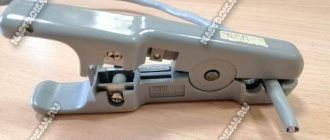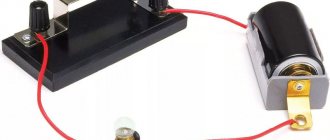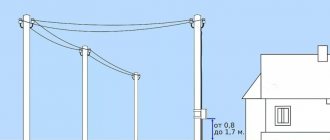What does an Ethernet cable look like?
Ethernet cables are similar to telephone cables, but they are larger and have more wires.
Both cables have the same shape and connector, but the Ethernet cable has eight wires and a larger connector, while the telephone connector has only four wires. Ethernet cables come in a variety of colors, but telephone cables are usually grey/black.
Of course, Ethernet cables connect to Ethernet ports, which, again, are larger than phone cable ports. The Ethernet port on the computer is accessible through the network card on the motherboard.
Expert opinion
Viktor Pavlovich Strebizh, lighting and electrical expert
Any questions ask me, I will help!
When purchasing, you need to pay attention to a number of criteria, otherwise a bad wire will cause a weak signal and constant loss of communication. If there is something you don’t understand, write to me!
twisted pair connector
To create reliable connections, connectors from the RJ series are used. This short abbreviation stands for Registered Jack. This translates to "registered connector". It was first created by Bell in 1975 with the goal of bringing the connectors used to a common denominator.
The entire series of these connectors is in one way or another related to connecting to networks. For example, a four-wire RJ9 is used to connect the handset to the device.
Used as a twisted-pair connector, RJ-45, by the way, is divided into two types - standard RJ-45 and RJ-45S. The first is used to create local networks, and the second is used to connect modems.
In fact, the term RJ-45, which has taken root in Russia, is called so erroneously because it is similar in appearance to RJ-45S, which uses four wires. However, the name is firmly attached to the local network connector, so this abbreviation will also be used in this article.
Expert opinion
Viktor Pavlovich Strebizh, lighting and electrical expert
Any questions ask me, I will help!
PoE technology, an abbreviation for Power on Ethernet, was created in order to provide power to network equipment without the use of additional cables, providing reference voltage transmission over twisted pair cables. If there is something you don’t understand, write to me!
Tools
To crimp an Internet cable at home, you need not only wire and connectors, but also a specific tool.
Cable
The stability of signal transmission depends on the correct choice of cable. You need to select a twisted pair cable of category CAT 5E and higher, preferably with four pairs. A wire with a fireproof braid will be more durable and reliable. Flat or round, it doesn't matter.
You need to consider where the wire will be located. If it is not put away in cable channels and is simply stretched around the room, the UTP type is suitable, otherwise you need to consider more expensive types of wire with a common shield or pair protection.
If you need to connect two PCs or a router and a PC with a cable, then a stranded wire is selected, but for ease of crimping it is better to use a single-core wire. For sockets - with one core.
Connector
In addition to the wire, you need to prepare a switching element, also known as a connector or Ethernet plug. Often referred to as RJ-45.
Many connectors have a similar design. Their body is made of transparent plastic for visual control of the crimping process. There is a latch on top that allows you to secure the plug after installation in the port. At the back there is a connector for cable entry, a little higher, on the case there is a fixing bar that ensures a reliable connection.
Inside, the connector consists of eight channels, the diameter of the cores. They go to the end wall of the plug, where there are 8 separate contacts. Initially, they are raised up and do not prevent the cable from entering through the channels until it comes into contact with the end wall. Each has pointed protrusions on the bottom.
When crimping, the contacts move down, pierce the insulation and establish a connection with the conductors. They are recessed flush with the surface of the connector and form contact pads for connecting to the port of a router, PC or other device.
Some connectors have auxiliary inserts that make it easier to correctly insert the cores into their positions under the contacts.
When purchasing connectors, you should also buy a protective cap. It is cheap, but it will protect the LAN cable from being bent, the latch from breaking, and the port and plug from dust.
Crimping tool
The following tool is used to crimp twisted pair cables:
- Crimper. These are crimping pliers. To crimp a connector, place the edge of the wires into them, then install the connector into the socket on the tool and squeeze the handles until they click. You need large pliers (light pliers break quickly), but comfortable and light so that your hand does not get tired. The crimper halves must be even in relation to each other, otherwise the plug will break during the crimping process of the wire.
- Stripper. A tool for cutting cables, stripping insulation, or otherwise working with it. Much more convenient than a simple stationery knife.
- Tester or multimeter for crimp diagnostics.
It is not necessary to use a professional tool for crimping, especially if laying the wire will be done once. But with it it will be easier to complete the task, and the result will be higher.
Crimping techniques
Each twisted pair cable has four colors. The pair has a conductor filled with a solid color and mixed with white. The palette is as follows - white-orange and orange, white-green and green, white-blue and blue, white-brown and brown.
Depending on the device connection parameters, different color options are used. That is, at one end of the cable there should be one pattern, at the other - another, or the same one, as will be shown below.
For example, when connecting a computer and a hub, the following color markings must be observed:
- White-orange - white-orange.
- Orange is orange.
- White-green - white-green.
- Blue - blue.
- White-blue - white-blue.
- Green is green.
- White-brown - white-brown.
- Brown - brown.
That is, color to color. And if you need to connect two computers or hubs, a special color scheme is used, which is commonly called “cross”:
As you can see, many colors have only slightly changed their location. The brown and blue pairs remained in their places, but the orange and green pairs changed.
By the way, many modern devices have learned to determine the placement of pairs automatically, which is undoubtedly convenient when creating large networks.
Cable interference protection
- chemical (from moisture, gas, ultraviolet radiation);
- mechanical (external influence factors - impacts, bends, twisting);
- shielding (from internal and external radiation from technical means of information processing).
Power is the root cause of the appearance of electrical signals operating in electrical networks. Shielding helps neutralize and reduce the influence of external electromagnetic fields on the Internet cable.
- FTP - isolated. They have a single signal suppressor;
- F2TP – double protection cord with a thin metal sheet;
- S/FTP. The insulated cores are protected, the surface covering is copper weaving;
- STP – individual conductors, the entire cable;
- U/STP. Each individual wire is covered with a thin sheet of metal;
- SF/UTP. There is a double coating of copper braid and metallic paper.
For home connections, in most cases, a four-pin UTP template is used. It is unshielded and susceptible to all kinds of energy emissions operating in electrical and magnetic networks. The most secure is FTP, which resists changes in the state of the electromagnetic field of artificial origin.
RJ-45 twisted pair connector: description, characteristics and types
A network cable used to switch connections between a computer and network equipment is crimped in two ways: straight and cross, which differ in the pressing of the cores in the connector.
Expert opinion
Viktor Pavlovich Strebizh, lighting and electrical expert
Any questions ask me, I will help!
Practically, all owners of existing communication channels with the world computer system use unshielded twisted pair UTP of the fifth category. If there is something you don’t understand, write to me!
General information
Very often there is a need to wire a home network of devices with Internet access. Solving the problem is very simple, since you need to purchase a router, configure it and connect all devices to it. In this case, cable crimping is necessary. There are two ways out of this situation: seek help from a specialist or perform the crimping yourself. Crimping a network cable is inexpensive, but in some cases it can be unprofitable, since you need to adjust and wait for a specialist to arrive.
In some cases, for convenience, you need to use your home network, since it is not very convenient to run with a flash drive from one computer to another and download your favorite show or movie. To do this, you need to know how to properly crimp a twisted pair with 8 cores.
Types of twisted pair
Twisted pair is a special cable consisting of a certain number of copper wires in a sheath, and they are twisted together in a certain way. The wires are twisted in a certain way in order to eliminate their influence on each other. Twisted pair cable is used for data transmission. The network cable is connected to devices through special connectors using connectors.
An Ethernet cable can be with or without protection. The protective sheath is made of aluminum foil or sheath (braid). Protection can be of two types: general and pairwise. General protection applies to the entire cable, and pairwise protection only to each pair. The network cable can be divided into several types:
- UTP.
- FTP.
- STP.
- S/FTP.
- S/STP.
- SF/UTP.
Types of network cables marked UTP (unshielded) or FTP (common foil shield) can be used indoors. If you need to lay communications outdoors, you should use an SF/UTP cable. If the Internet wire is laid together with an electrical cable, it is necessary to use STP or S/STP, which provides protection for each pair and a double screen (length more than 100 m). The S/FTP cable (each pair and the cable itself is shielded) is designed for use in environments with high noise levels.
Each core of an Ethernet cable can consist of one (single-core) or many (multi-core) conductors. Single-core wires bend poorly, but have improved characteristics that affect the signal transmission distance. They crimp better, are fixed and practically do not bend. A network cable, the cores of which consist of one conductor, is used to connect Internet outlets.
Twisted pair wires, the wires of which contain many conductors, bend well, but have high attenuation during signal transmission. It is difficult to crimp it because you can cut through the insulation. It is difficult to insert into the connector and is used in cases where flexibility is important (from an Internet outlet to a personal computer).
Category and containment
The twisted pair category is very important. To connect to the Internet or conduct communications for a computer network, you should use a category of at least CAT5. In exceptional cases, CAT6 and CAT6a are suitable. Category designations are embossed on the shell. There are a total of 7 types of categories for twisted pair:
- I - 1 pair (bandwidth 0.1 MHz): used in telephone communications.
- II - 2 (1 MHz): networks with data transfer rates up to 4 Mbit/s.
- III - 4 (16 MHz): 10 and 100 Mbit/s.
- IV - 4 (20 MHz): up to 16 Mbit/s.
- V - 4 (100 MHz): 100 Mbit/s (2 pairs are used).
- Ve - 4 (125 MHz): 100 Mbit/s (2 pairs) and 1 Gbit/s (4 pairs).
- VI - 4 (250 MHz): from 1 to 10 Gbit/s.
- VII - 4 (600 MHz): shielded up to 10 Gbit/s.
You might be interested in this Review of effective methods and types of neutral grounding
Twisted pair also differs in the shape and color of the sheath. The common type of power cord is gray sheath. The orange (bright red) color of the sheath indicates that the power cord does not support combustion. The latter type of wire makes sense to use in areas prone to fire. In addition, twisted pairs are flat and round. They do not differ in technical characteristics.
The Ethernet cable consists of 2 (4 wires) or 4 (wires) pairs. At speeds up to 100 Mbit/s, 2 pairs can be used. If the data transfer rate is in the range from 100 Mbps to 1 Gbps (1000 Mbps), then all 8 wires (pairs) should be used. When designing your home network or connecting to the Internet, you should take these features into account. It is better to stretch 4 pairs at once, since if the information transmission speed increases above 100 Mbit/s, you will have to re-tighten the cable.
Connection to the connector
It is used when replacing a failed special item for connecting to a provider’s wire, connecting a personal computer to a router with a twisted pair cable, connecting two computers on a local network. Represents the fastening of special disconnectors at the ends of the cord.
A network cable used to switch connections between a computer and network equipment is crimped in two ways: straight and cross, which differ in the pressing of the cores in the connector.
Computer-to-computer (cross-cross) is used to connect similar devices: computer-to-computer, router-to-router, TV-to-computer. Named for the cross arrangement of the connector cores. One end is crimped with a direct connection, the other with a modified sequence.
Useful tips Connection diagrams Principles of operation of devices Main concepts Meters from Energomer Precautions Incandescent lamps Video instructions for the master Testing with a multimeter
Tool-free crimping
If there is no crimper, you will have to use existing tools, for example, a screwdriver. The braid is removed with a simple sharp knife. You need to act carefully so as not to spoil the integrity of the core insulation. The contacts are cut to the appropriate length using side cutters.
To properly crimp a twisted pair, the wire is placed in the connector and clamped with a strip so as not to be pulled out by negligence. Next, you need to lay the connector on a flat surface and use a slotted screwdriver to press the contacts one by one so that they push through the insulation and cut into the cores. Now you should make sure that all contacts are pressed in completely and are at the same level.
Using special self-crimping connectors
There are self-crimping connectors that do not require tools other than those used to remove braiding and insulation to crimp a twisted pair of 8 cores.
The principle of crimping using such structures is simple. You need to open the connector and insert the wires into the grooves from above (the connectors are painted in different colors, so it is impossible to make a mistake with the correct location). Then close the halves. The wires will be pushed onto the contact blades. Now the connector can be used.
